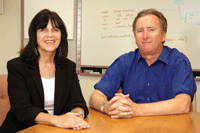Ever since the attacks of Sept. 11, one problem that has dogged first responders at all levels of government is the lack of interoperable communications.But a tool developed at the Navy's Space and Naval Warfare Systems Center-San Diego is being used to tackle the problem'not by spending a lot of money on new equipment and trying to figure out who gets priority allocation of scarce resources, but by tracking the equipment already out there and identifying how it all fits together.The Communication Assets and Survey Mapping (CASM) tool is an online database and visual display that provides information on communications equipment and identifies both existing interoperable pathways and where the gaps fall among local, state and federal first responders. It comprises two Web-based components: one for collecting data and one for displaying it.The Homeland Security Department gave the tool its first test in the aftermath of Hurricane Katrina.The Interoperable Communications Technical Assistance Program (ICTAP), based at SPAWAR-San Diego, started gathering communication assets data for New Orleans in July 2005. After the hurricane passed through the area at the end of August, CASM was the only readily available source of information on antenna locations. As agencies throughout the country assembled to support recovery efforts, New Orleans used CASM to augment surviving paper records to restore emergency communications.CASM was so useful that when Hurricane Wilma approached the Florida coast in October, Nancy Dzoba, head of the Florida Regional Domestic Security Task Force-Region Seven, in Miami, requested access to the information that had been collected for CASM in her region. (Although it's a shared database, each region that contributes information is also the only authority that can grant access to its data.) Dzoba also received access to the information for the Tampa and Orlando regions, which serve as mutual aid partners in the state.'The database saved us valuable hours of technical research,' Dzoba said. Due in no small part to the valuable hours that the development team put into stitching together the system.'The way CASM initially started was out of necessity,' said Bob Ryder, the ICTAP technology tools manager who led the development program. 'We had to collect data for land mobile radios.'Ryder's team started to gather the information on paper; normally it would have been transferred to a database on a computer, but they realized they could cut out that middle step, he said.'We patched some forms together really quickly [for] a computer assets survey,' he said. 'It kind of evolved from there. We wondered, how hard would it be to display the information?'The Urban Area Security Initiative is a DHS effort set up by the Grants and Training Office within the Preparedness Directorate to coordinate efforts to improve more densely populated areas' ability to respond to emergencies. ICTAP provides the CASM tool free to the communities that receive UASI grants to assist in enhancing those communities' interoperable communications efforts.CASM maintains a master database of communication assets information'elements such as agencies, radio systems, towers, gateways, dispatches and other components.The system runs on a server housed at SPAWAR and it's built on the open-source LAMP stack (consisting of Linux, Apache, MySQL and scripting language PHP). It uses MapServer, an open-source development environment for building spatially enabled Internet applications, to generate its display. For security, it was configured to provide for server-side, certificate-based authentication, and it provides Secure Sockets Layer encrypted communications.Most of the data included in CASM is publicly available, but aggregated in this way it is considered 'public safety sensitive''thus the safeguards against unauthorized access. The developers built a series of Web-based survey forms to help participants submit additional information about communication assets. These forms were designed to automatically validate the data and structure it in a way that avoids duplication. With multiple overlapping jurisdictions contributing to the project, this type reality check is important so the system can accurately identify communication paths.When federal, state and local officials converge on a location, algorithms built into the software map the possible interoperability paths among assets in that area, Ryder said; the graphical interface provides a visual understanding of those communications paths, so users can actually see possible solutions for interoperability with existing equipment. When users bring up the communication asset tool, they see a map with color-coded lines indicating levels of compatibility. In fact, the tool can generate an 'interoperability matrix' to help identify the highest level of interoperable communication between two agencies.From the map, users can then click on assets and drill down further into exactly what the assets are, what standards they support, and so on. All information is organized in accordance with the Project Safecom Interoperability Continuum. Safecom is a presidential initiative launched in 2002 to foster first-responder interoperability [for more, see , GCN.com/693].Which leads to another potential benefit of CASM'saving money for agencies already stretched for cash.'We can come in as honest brokers' because CASM doesn't require additional technology, Ryder said. 'We can say, 'Here's a much lower-cost solution.' 'Keith Young, the ICTAP program manager in the Grants and Training Office of DHS, said that CASM has been a great success.'We're very happy with it,' he said, 'the way it impacts the level of what we're doing in terms of comparable communications initiatives with states and locals. ... [They] can input their data and give geospatial representations to anyone who has access.'Young said CASM also has been very well received by the states and localities that are now using it.'Now that they've done their tactical and interoperability plans required for urban areas, the states would like to make them [into] statewide plans using CASM,' he said.Since CASM was launched in July 2005, more than 5,000 agencies in 2,500 jurisdictions have supplied agency and communication data. The tool is used in more than 45 urban areas, covering roughly 1,500 logins per month.Even if first responders throughout the United States eventually move to communications systems with greater interoperability, Ryder said, CASM will have usefulness.It 'is an interoperable communications planning tool and equipment information store,' he said. 'It is also eventually going to include 'data' interoperability information in a future release.'
ON THE RADIO: SPAWAR senior scientist Rita Lane and ICTAP technology tools manager Bob Ryder, who led development of the program to inventory communications assets.
Courtesy Bob Ryder







